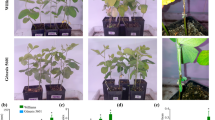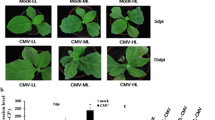Abstract
In this study, we examined the necrosis phenotype on leaves of two cultivars of soybean (ZheA8901 and Nannong1138-2) that show varying level of resistance to soybean mosaic virus (SMV). The necrotic symptoms seen on inoculated and systemic leaves of soybean cultivar ZheA8901 were reminiscent of programmed cell death (PCD). The cell death phenotypes were evaluated using the TUNEL method, quantification of hydrogen peroxide (H2O2) and salicylic acid, callose production, as well as by monitoring expression of defence genes GmPR-1 and GmNPR1. Our results show that SMV inoculation induced PCD on ZheA8901 is associated with rapid increase in H2O2, increased SA and callose accumulation and higher defence gene expression.





Similar content being viewed by others
References
Allison, A. V., & Shalla, T. A. (1974). The ultrastructure of local lesions induced by potato virus X: a sequence of cytological events in the course of infection. Phytopathology, 64, 784–793.
Atsumi, G., Kagaya, U., Kitazawa, H., Nakahara, K. S., & Uyeda, I. (2009). Activation of the salicylic acid signaling pathway enhances Clover yellow vein virus virulence in susceptible pea cultivars. Molecular Plant - Microbe Interactions, 22, 166–175.
Bowling, S. A., Guo, A., Cao, H., Gordon, A. S., Klessig, D. F., & Dong, X. (1994). A mutation in Arabidopsis that leads to constitutive expression of systemic acquired resistance. Plant Cell, 6(12), 1845–1857.
Carlos, A. A., & James, E. S. (2013). A survey of resistance to tomato bushy stunt virus in the genus nicotiana reveals that the hypersensitive response is triggered by one of three different viral proteins. Molecular Plant-Microbe Interactions, 26(2), 240–248.
Chandra-Shekara, A. C., Navarre, D., Kachroo, A., Kang, H. G., Klessig, D., & Kachroo, P. (2004). Signaling requirements and role of salicylic acid in HRT- and rrt-mediated resistance to turnip crinkle virus in Arabidopsis. Plant Journal, 40(5), 647–659.
Conrath, U., Klessig, D., & Bachmair, A. (1998). Tobacco plants perturbed in the ubiquitin-dependent protein degradation system accumulate callose, salicylic acid, and pathogenesis-related protein 1. Plant Cell Reports, 17(11), 876–880.
Delaney, T. P., Uknes, S., Vernooij, B., Friedrich, L., Weymann, K., Negrotto, D., et al. (1994). A central role of salicylic acid in plant disease resistance. Science, 266(5188), 1247–1250.
Delledonne, M., Xia, Y., Dixon, R. A., & Lamb, C. (1998). Nitric oxide functions as a signal in plant disease resistance. Nature, 394(6693), 585–588.
Gaffney, T., Friedrich, L., Vernooij, B., Negrotto, D., Nye, G., Uknes, S., et al. (1993). Requirement of salicylic acid for the induction of systemic acquired resistance. Science, 261(5122), 754–756.
Gavrieli, Y., Sherman, Y., & Ben-Sasson, S. A. (1992). Identification of programmed cell death in situ via specific labeling of nuclear DNA fragmentation. The Journal of Cell Biology, 119(3), 493–501.
Gilbertson, R. L., & Lucas, W. J. (1996). How do viruses traffic on the ‘vascular highway’? Trends in Plant Science, 1(8), 250–251.
Greenberg, J. T., & Yao, N. (2004). The role and regulation of programmed cell death in plant-pathogen interactions. Cellular Microbiology, 6(3), 201–211.
Hofmann, J., Youssef-Banora, M., de Almeida-Engler, J., & Grundler, F. M. (2010). The role of callose deposition along plasmodesmata in nematode feeding sites. Molecular Plant-Microbe Interactions, 23(5), 549–557.
Iglesias, V. A., & Meins, F. (2000). Movement of plant viruses is delayed in a β-1, 3-glucanase-deficient mutant showing a reduced plasmodesmatal size exclusion limit and enhanced callose deposition. Plant Journal, 21(2), 157–166.
Kachroo, P., Chandra-Shekara, A. C., & Klessig, D. F. (2006). Plant signal transduction and defense against viral pathogens. Advances in Virus Research, 66, 161–191.
Kawakami, S., Watanabe, Y., & Beachy, R. N. (2004). Tobacco mosaic virus infection spreads cell to cell as intact replication complexes. Proceedings of the National Academy of Sciences of the United States of America, 101(16), 6291–6296.
Kranthi, K. M., & Karen-Beth, G. S. (2013). Plant immune responses against viruses: how does a virus cause disease? Plant Cell, online.
Levine, A., Tenhaken, R., Dixon, R., & Lamb, C. (1994). H2O2 from the oxidative burst orchestrates the plant hypersensitive disease resistance response. Cell, 79(4), 583–593.
Li, K., Yang, Q., Zhi, H., & Gai, J. (2010). Identification and distribution of soybean mosaic virus strains in southern China. Plant Disease, 94(3), 351–357.
Li, W., Zhao, Y., Liu, C., Yao, G., Wu, S., Hou, C., et al. (2012). Callose deposition at plasmodesmata is a critical factor in restricting the cell-to-cell movement of Soybean mosaic virus. Plant Cell Reports, 31(5), 905–916.
Lorang, J. M., Sweat, T. A., & Wolpert, T. J. (2007). Plant disease susceptibility conferred by a “resistance” gene. Proceedings of the National Academy of Sciences of the United States of America, 104, 14861–14866.
Luna, E., Pastor, V., Robert, J., Flors, V., Mauch-Mani, B., & Ton, J. (2011). Callose deposition: a multifaceted plant defense response. Molecular Plant-Microbe Interactions, 24(2), 183–193.
Miklós, P., Julia, K., Ingrid, H., Erich, F. E., & Balázs, B. (2004). Juvenility of tobacco induced by cytokinin gene introduction decreases susceptibility to Tobacco necrosis virus and confers tolerance to oxidative stress. Physiological and Molecular Plant Pathology, 65(2004), 39–47.
Niderman, T., Genetet, I., Bruyère, T., Gees, R., Stintzi, A., Legrand, M., et al. (1995). Pathogenesis-related PR-1 proteins are antifungal. Isolation and characterization of three 14-kilodalton proteins of tomato and of a basic PR-1 of tobacco with inhibitory activity against Phytophthora infestans. Plant Physiology, 108(1), 17–27.
Padder, B. A. (2014). Plant disease resistance genes: from perception to signal transduction. Plant Signaling: Understanding the Molecular Crosstalk, 20, 345–354.
Patterson, B. D., MacRae, E. A., & Ferguson, I. B. (1984). Estimation of hydrogen peroxide in plant extracts using titanium(IV). Analytical Biochemistry, 139(2), 487–492.
Pontier, D., Godiard, L., Marco, Y., & Roby, D. (1994). Hsr203J, a tobacco gene whose activation is rapid, highly localized and specific for incompatible plant/pathogen interactions. Plant Journal, 5(4), 507–521.
Rauscher, M., Adám, A. L., Wirtz, S., Guggenheim, R., Mendgen, K., & Deising, H. B. (1999). PR-1 protein inhibits the differentiation of rust infection hyphae in leaves of acquired resistant broad bean. Plant Journal, 19(6), 625–633.
Scala, A., Mirabella, R., Mugo, C., Matsui, K., Haring, M. A., & Schuurink, R. C. (2013). E-2-hexenal promotes susceptibility to Pseudomonas syringae by activating jasmonic acid pathways in Arabidopsis. Frontiers in Plant Science, 4, 1–11.
Seo, Y. S., Rojas, M. R., Lee, J. Y., Lee, S. W., Jeon, J. S., Ronald, P., et al. (2006). A viral resistance gene from common bean functions across plant families and is up-regulated in a non-virus-specific manner. Proceedings of the National Academy of Sciences of the United States of America, 103, 11856–11861.
Séron, K., & Haenni, A.-l. (1996). Vascular movement of plant viruses. Molecular Plant - Microbe Interactions, 9(6), 435–442.
Soosaar, J. L., Burch-Smith, T. M., & Dinesh-Kumar, S. P. (2005). Mechanisms of plant resistance to viruses. Nature Reviews Microbiology, 3(10), 789–798.
Acknowledgments
This work was supported by the National Natural Science Foundation of China (Grant No. 31171574, 31101164), the National Soybean Industrial Technology System of China (No. CARS-004) and the Fund of Transgenic Breeding for Soybean Resistance to Soybean Mosaic Virus (No.2008ZX08004-004), the 111project (B08025) and PAPD.
Author information
Authors and Affiliations
Corresponding author
Rights and permissions
About this article
Cite this article
Zhang, K., Song, Y.P., Wang, Y. et al. Differential necrotic lesion formation in soybean cultivars in response to soybean mosaic virus. Eur J Plant Pathol 139, 525–534 (2014). https://doi.org/10.1007/s10658-014-0408-7
Accepted:
Published:
Issue Date:
DOI: https://doi.org/10.1007/s10658-014-0408-7




